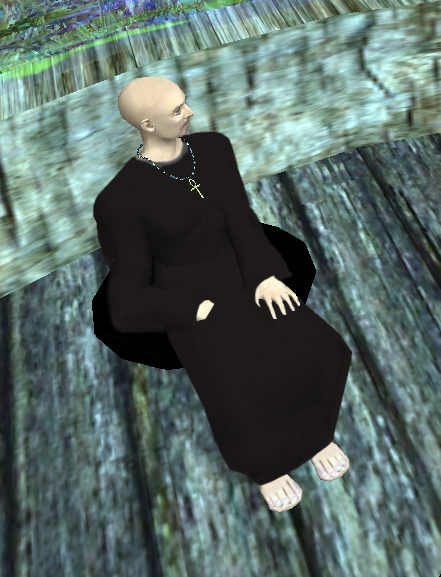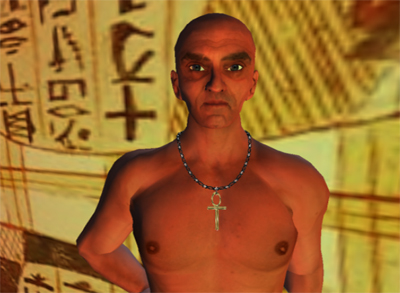Soon I was spending a lot of time in Egypt. Often twelve or more hours a day. I began to feel a pressing need to improve my avatar’s appearance again. I was still wearing the robe Seti had recommended at the time I joined Ptolemaic Egypt and the default avatar skin. As can be seen in the image of an avatar from this time (see figure 12) the robe was a very plain affair and didn’t look particularly Egyptian. The skin didn’t look like real human skin and the details were simple in the extreme, e.g. toes were just lines drawn on the background. I was comparing my avatar to those of other avatars in the sims and finding it wanting. I was embarrassed on behalf of my avatar. This embarrassment had two expressions. On the one hand I would talk to my avatar and express how I felt sorry for him for having such a basic skin and outfit. On the other hand I would feel embarrassment for myself on account of his outfit. He was simultaneously an other and yet myself. I felt his embarrassment both vicariously and at one remove. Yet how can an avatar have embarrassment for me to experience vicariously? He had no consciousness, as far as I knew. He never actually spoke to me to tell me he did anyway. Yet there it was. I went shopping.

At this time the first photorealistic avatar skins were appearing. Up until this time avatar skins had been drawn and as a result looked pretty cartoon like. But Second Skin Labs had just introduced a range of skins that were renowned for their realism. Many people spoke of them but few purchased them due to their price. At $L10,000 they were far and away the most expensive item I had seen for sale in the world. But they were beautiful (see figure 13). Fabulously realistic, with exceptional detail, the like of which I had never seen before in an avatar skin. They made the avatar look like a real person rather than a cartoon facsimile. The skin was rendered in great detail, and, best of all, it wasn’t perfect. It was a real person’s skin, with wrinkles and imperfections. It had a scar on the face! I had to have it. I figured it was less than I spent on cups of coffee for a week, and I would certainly get more mileage out of it than I did the coffee.

As tempting as it was to have Thutmose walk around naked so I could behold the beauty of his new skin, clearly such a handsome fellow would need a new outfit. There was just one problem. I hated shopping. It was laborious. Web based online digital goods marketplaces were only just beginning and had a very limited range of items. Most merchants I spoke to felt they would never take off as they thought people preferred to visit inworld stores. This turned out to be wildly inaccurate, with web based marketplaces now accounting for the vast majority of sales of digital goods.
There are many drawbacks to traipsing around shops in the world. First one had to find them. The Second Life’s inworld search (and later the Marketplace search) was bad, famously bad1 2 3, and it remains so to this day. So bad that everyone relied heavily on personal recommendations from others as to the locations of useful shops. This meant that one had to have good connections with others in order to find the best stuff, which of course made it very hard for new users. They would be able to see other avatars dressed in good quality, relevant attire, but have no hope of finding out where to obtain it without asking. When asked, many people would refuse to say where they had obtained an item lest they soon discover every other avatar in the community wearing the same thing. This lack of an adequate search facility was, and continues to be, one of the major Achilles heels of the world. New residents just can’t find things. As far as goods go this situation has been ameliorated by the web based marketplaces, but for events and destinations it still holds true. Once one has found a shop one wishes to visit, one must then go there. There was no way to be sure than any given merchant might even have the goods one sought in their shop without actually visiting it. Arriving in a new sim means a delay while the sim rezzes. This means bandwidth is used, and bandwidth is expensive. I knew of many users of the world who only ever stayed in the one place as their data plans didn’t afford them enough bandwidth to allow them to go anywhere. Even if one did frequent the same place the caching in the Second Life client was so bad that almost everything was reloaded each time one returned. Invariably one would arrive in the shop and wait for the world to rez, and wait, and wait. Shops have lots of items in them. The more items, the longer it takes to download. Adjusting one’s draw distance helped, but there was always a delay. One would have to set a reasonably high draw distance if one had any hope of finding one’s way around a shop. Shopping was not fun, for me, though many people loved it and did little else.
Then came the digital goods web stores. They began to spring up, metaverse exchange, MySLMarket, but the most popular was Xstreet. There one could peruse items for sale in the world on a web page rather than having to tediously tramp around the world. Their searches were also pretty ordinary, but at least less bandwidth was used visiting them than visiting shops in the world. They made shopping whole orders of magnitude less time consuming. The people who loved shopping would spend hours visiting shops and finding stuff. These were the people one had to know if one wanted to find the best stuff. Perhaps unsurprisingly most of these were female avatars. This meant that those of us with male avatars had a much harder time finding things.
At the time I had an ADSL 1 connection. ADSL stands for asymmetric digital subscriber line, the asymmetric part creating a bottle neck when using Second Life. With an asymmetric technology speeds for downloading and uploading differ, with the speed for downloading being much faster than that for uploading. Asynchronous technologies have been the norm since the demise of dial up connections and ISDN (Integrated Services Digital Network). These technologies suit most home internet users as normal internet traffic usually results in more data coming into the user’s home than going out. For example, in normal web browsing a user will visit a number of websites and will need to download the data that comprises the web pages from the site, images, text, sound files and so on, but they will only upload a small amount of data, as the only uploaded data is that used for the purpose of verifying the receipt of the downloaded data or any data inputted by the user into forms etc. ADSL usually provides a maximum download speed of 8 megabits and a maximum upload speed of 1.3 megabits. However the speed varies with distance from the exchange and also varies depending on where the traffic is coming from. Second Life had no servers in Australia, so I was always connecting to a US server and I found that I actually achieved speeds of around 1.2 megabits down and 175 kilobits up. This was at the low end of the range of speeds required to allow Second Life to function adequately.
The problem of this low level of available bandwidth was compounded by the fact that Second Life requires both a higher ratio of upload to download speed than web traffic and a large amount of overall traffic. This is because Second Life requires real time interaction. When accessing the world one is not only downloading the large quantity of data from the server required to describe the world; terrain, objects, textures, scripts, sounds, et cetera, which all change constantly as one moves around in the world, but also one needs to be constantly exchanging information with the server about the position of other avatars around one, while simultaneously transmitting the data that describes the movements of one’s own avatar. Additionally Second Life has the capacity for voice calls between users, another high bandwidth application. Moreover in addition to these basic functionalities required to simply use the world, building in Second Life requires that one must upload textures, sounds, scripts, video files, and so on, which also require a great deal of data to be uploaded. This means that not only does one require a fast internet connection, one also requires a lot of data. Internet access plans in Australia and the UK are often priced by how much data one uses, although some American users had unlimited data plans.
There are ways to mitigate bandwidth problems. One of the most effective was to control one’s draw distance, which controls how far away from the avatar the world would be rendered. The higher the number set, the more data would be required. Setting the draw distance too high might result in one using one’s entire month’s data allowance in a few hours if one didn’t have a very expansive data allowance. But adjusting this setting has complications. A group of avatars might be interacting in the world and one of them might try to direct the attention of the others to an object some distance away. This might result in puzzled responses from those compelled to have a low draw distance value set on account of either the speed of their connection or the amount of data they have purchased from their ISP. This is another aspect of the problem of not having any feedback on what other avatars are seeing which I discussed earlier.
While it is true that this is a limitation of Second Life that makes some tasks that are easily performed in meatspace much harder to perform in the world, this is in fact an exact parallel with the way we walk around imagining that everyone else is seeing the world exactly the same way we do. We imagine that all humans are equally sighted for example. This leads us to experience difficulties when we have to interact with differently sighted others. I found this aspect of the world a particularly enlightening experience, as it made me much more aware of this phenomenon. As a result I became more mindful of others. I was constantly forced to spend more time trying to put myself into the other person’s position lest we have massive communication failures. But I also experienced this in other ways. Having to consider how people visually saw the world made me consider how they conceptually saw the world. Were they from the same linguistic background as I? The same cultural background, the same philosophical background?
- Second Life Forum, (2012), SL search is broken all time – Let’s build up a better search!, http://community.secondlife.com/t5/Wanted/SL-search-is-broken-all-time-Let-s-build-up-a-better-search/td-p/1515729, Accessed 02/04/2014. ↩︎
- Second Life Forum, (2011), Search Does NOT Work!!!, http://community.secondlife.com/t5/Second-Life-Viewer/Search-Does-NOT-Work/td-p/763479, Accessed 02/04/2014. ↩︎
- Saarinen, C., (2010), Second Life’s Class Warfare and the Gentleman from San Francisco, http://secondthoughts.typepad.com/second_thoughts/2010/06/class-warfare-and-the-gentleman-from-san-francisco.html, Accessed 02/04/2014. ↩︎